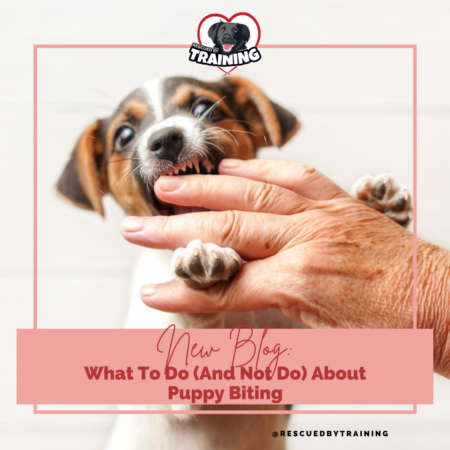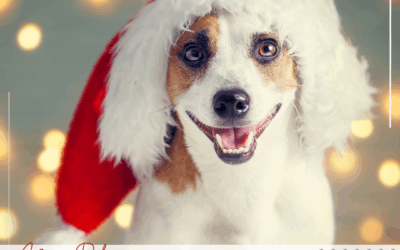Did you know that puppy biting and mouthing is completely normal dog behavior? While it may be annoying (and painful!), especially if you’ve got small children, it is a normal part of your dog’s development. Puppies explore their worlds with their mouths (and noses) so picking things up in their mouth is like human babies touching things. This is normal, species appropriate behavior and we cannot, and should not expect dogs to not do it. Let’s dive into what you should and shouldn’t do about puppy biting so that your dog learns how to appropriately use its mouth.
Let’s start with what NOT to do, because doing these things can cause actual harm.
- Do not squeeze your puppy’s mouth shut. This will not teach your puppy not to bite but very well may make your dog hand-shy or fearful or people reaching towards him. This can have long lasting effects, as your dog won’t know if you’re reaching towards him to clamp his mouth shut or to pet him.
- Do not hit or “tap” your dog’s muzzle, no matter how gentle. Just like above, this can lead to fear of people or hands or reaching and will not teach him not to bite. It will just make you scary to your dog.
- Do not “alpha roll” your dog or “bite” him with your hands. Besides the fact that we know this type of training isn’t effective (and can be harmful), you are not a dog. Even if domestic dogs had alpha hierarchy, it wouldn’t cross species. Newsflash: you’re a human, not a dog, and using these methods are not effective and will only scare your dog.
- Do not yell at your dog. I’ve covered why No Is Not A Behavior before and especially with impressionable puppies, we need to ensure we are not doing anything to scare or startle your dog. Yelling or raising your voice only serves to startle or temporarily interrupt behavior, but your dog doesn’t learn anything positive in this interaction.
- Do not spray your dog with water. Spraying your dog with water (or anything) may temporarily startle your dog but this can cause fear of you, of bottles and of water. Bathtime will be especially hard in the future if you’ve scared your dog with water.
- Do not use Bitter Apple or any other taste deterrent. Not only is this ineffective (are you going to spray all the items in your whole house?) but punishing your dog with foul tasting spray because you didn’t properly manage him is inhumane. If your dog is chewing on inappropriate items, he’s communicating his needs are not being met and no species should be punished for communicating.
Now, what should you do?
- Give your puppy appropriate and varied chew items. Your dog needs lots of different chew items that are appropriate. These should vary in texture and hardness. Just having soft chew toys won’t fulfill your dog’s desire to chew on harder items (like chair legs!).
- Be proactive instead of reactive. Set your dog up for success by giving him appropriate toys before he starts inappropriate biting. Put things away that the puppy shouldn’t be chewing on or that might be dangerous. Do not expect a puppy to make good decisions. Confine or crate your dog when he cannot be 100% supervised. This isn’t mean, it is helping your puppy be set up for success so he doesn’t hurt himself or rehearse chewing on things he shouldn’t. Instead of preventing the puppy from getting into a situation, we let them get into a situation and then we’re left scrambling to get out of it. We try to redirect puppies after they’re already biting instead of setting them up for success before it happens. Additionally if we rely too heavily on redirecting after biting starts, we could inadvertently be teaching the puppy the way to get someone to interact with them or get a toy is to bite their human, so we’ll get an increase in biting for attention seeking.
- Make sure all your dog’s needs are being met. Dogs who don’t have appropriate outlets for species specific behaviors like sniffing, chewing, digging, scavenging and dissecting can get frustrated and biting/chewing is a great way to burn off energy for a dog.
- Teach your dog appropriate bite inhibition. Learning how to properly use their mouth is a skill that puppies acquire at a very early age through play with other puppies, which is one of the reasons remaining with littermates until 8-12 weeks is so important. We cannot and should not expect dogs not to use their mouths, but we can teach them at an early age how to softly use their mouth. Allow gentle biting (I call them love bites) to teach them bite inhibition but hard biting should not be allowed (see below).
- Use gentle timeouts by removing yourself from the puppy after giving a gentle warning cue on the first hard bite. (I use “careful” as my warning cue.” If the puppy continues to bite hard after the warning cue, I quietly get up and remove myself so there is a consequence of “we were playing and having a good time, but you bit too hard and it chased me away and the fun stopped.” Timeouts should never be mean or scary for the dog but they can be an excellent way to implement a consequence to help reduce unwanted behavior. Want more info on how dogs learn? Grab my free download.
It’s important to note all of this is only applicable to normal, puppy mouthing and age appropriate teething (most puppies lose their baby teeth around 3-5 months). If you have a fearful puppy or dog, biting in that context is very different and requires a much different approach to training and management.
If you need help, grab your one on one session with me here! And, be sure to sign up for my free weekly newsletter so you don’t miss out on free tips, videos, personal stories, client successes and more!
Happy training!
![]()




